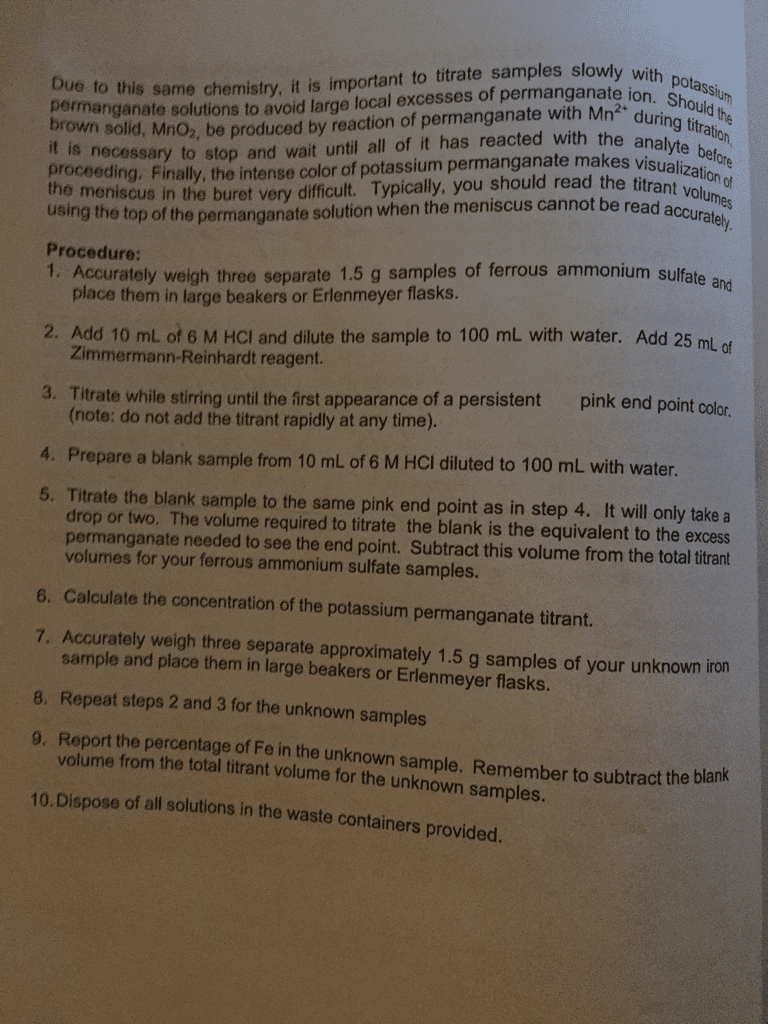pipette 50 ml of the approximately 0.004 M potassium permanganate solution to a 250 ml conical flask. Note that this time the permanganate is added to the contents of the flask by pipette rather than from the burette - the principle being that it is present in excess so that the pink colour shou ld remain strongly after the nitrite addition . Using a measuring cylinder , add 25 ml of 2 M sulphuric acid. Pipette 25 ml of the previously prepared approximately 0.0100 M â sodium nitrite â solution to this flask . Mix the solutions thoroughly. v. Back t itration of remaining permanganate against iron(II) ammonium sulphate The residual pink colour as a result of the remaining excess permanganate ions is titrated against the approximately 0.02 M iron (II) ammonium sulphate solution (in the burette) , whose ac curate concentration was determined in step (iii) . Titrate until the pink becomes very faint , as in ; add 1 ml of N - phenylanthranilic acid and titrate to the colour change from purple to yellow.
From the result of your titration in part (v), calculate the number of moles of permanganate ion in the solution, and hence the number of moles of permanganate that reacted with nitrite ion in step (iv). From this, calculate the number o f moles of nitrite ion in 25 ml of the original approximately 0.0100 M solution, and then the actual concentration of sodium nitrite in this solution in mol dm â 3 . Hence calculate the percentage purity of the supplied sodium nitrite
Mass of sodium nitrite used = 1.7275 g
pipette 50 ml of the approximately 0.004 M potassium permanganate solution to a 250 ml conical flask. Note that this time the permanganate is added to the contents of the flask by pipette rather than from the burette - the principle being that it is present in excess so that the pink colour shou ld remain strongly after the nitrite addition . Using a measuring cylinder , add 25 ml of 2 M sulphuric acid. Pipette 25 ml of the previously prepared approximately 0.0100 M â sodium nitrite â solution to this flask . Mix the solutions thoroughly. v. Back t itration of remaining permanganate against iron(II) ammonium sulphate The residual pink colour as a result of the remaining excess permanganate ions is titrated against the approximately 0.02 M iron (II) ammonium sulphate solution (in the burette) , whose ac curate concentration was determined in step (iii) . Titrate until the pink becomes very faint , as in ; add 1 ml of N - phenylanthranilic acid and titrate to the colour change from purple to yellow.
From the result of your titration in part (v), calculate the number of moles of permanganate ion in the solution, and hence the number of moles of permanganate that reacted with nitrite ion in step (iv). From this, calculate the number o f moles of nitrite ion in 25 ml of the original approximately 0.0100 M solution, and then the actual concentration of sodium nitrite in this solution in mol dm â 3 . Hence calculate the percentage purity of the supplied sodium nitrite
Mass of sodium nitrite used = 1.7275 g

